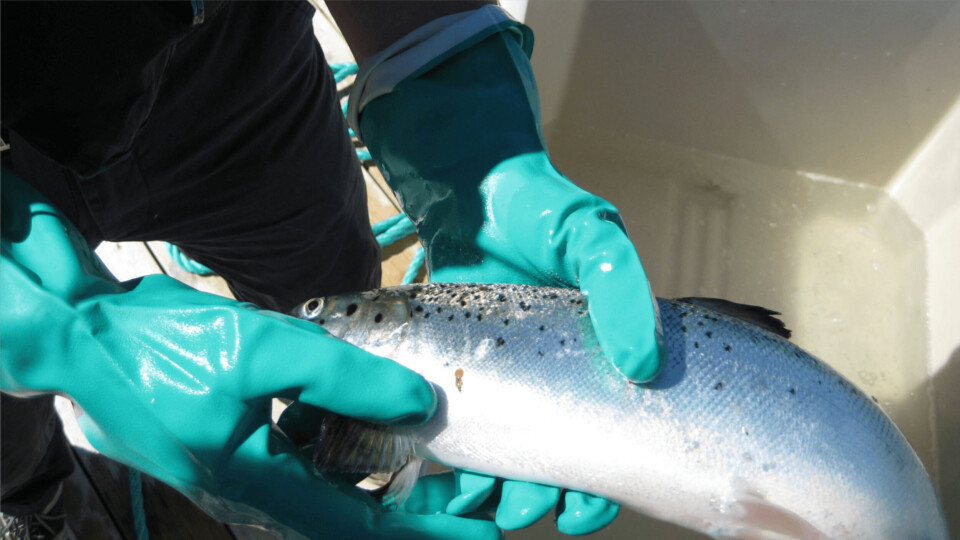
£1.7m study seeks to unlock secrets of salmon sea lice resistance
Scientists in Scotland have been given £1.7 million for a study to identify genes that could make Atlantic salmon resistant to sea lice.
The researchers aim to pinpoint key genes and associated biological processes underlying genetic resistance to the parasites.
This will include studying the response to lice attachment exhibited by coho salmon, a species of salmon which is fully resistant to sea lice, and then applying knowledge gained concerning mechanisms of resistance to Atlantic salmon, which is susceptible.
Coho salmon
The project is led by researchers from Edinburgh University’s Roslin Institute and the University of Stirling’s Institute of Aquaculture and will receive a total of £1.7 million from the Biotechnology and Biological Sciences Research Council (BBSRC) and the Sustainable Aquaculture Innovation Centre (SAIC). It is an industrial partnership award with aquaculture breeding company Benchmark Genetics.
Researchers will use data previously collected from 12,000 lice-infected fish to identify regions of the salmon genome associated with resistance to sea lice.
They will also compare Atlantic salmon with coho salmon to investigate the key mechanisms, genes and proteins involved in their different responses to lice.
Gene editing
Gene editing will be used to validate and shortlist genes and processes that could be linked to resistance, through tests examining the effects of “silencing” genes of interest.
Initial research will be conducted in fish cells, to identify the genes that are most likely to be involved in resisting infection by lice. These genes will then be targeted to produce gene-edited salmon embryos.
Gene editing, which enables targeted, precise changes to the genetic code, has been used in previous studies by scientists from the Roslin Institute to identify disease resistance genes in salmon, and has potential applications in aquaculture breeding to improve health and welfare traits. Selective breeding to increase resistance of salmon to lice is an effective but relatively slow process because a generation of salmon takes up to four years to reach maturity for reproduction.

Targeted changes
“Gene editing has potential to expedite the breeding of disease-resistant salmon by making targeted changes, informed by years of research into the genetic and functional mechanisms of resistance to sea lice,” said Professor Ross Houston, who holds a personal chair in aquaculture genetics at Roslin and recently joined Benchmark Genetics as its genetics innovation director.
“Work by our consortium aims to improve fish health and welfare, and enhance the sustainability of the salmon aquaculture sector, which is worth approximately £1 billion per year to the UK economy and is a major source of employment in rural communities of the Scottish Highlands.”
Transfer resistance
Dr Diego Robledo, research group leader at Roslin, said: “Different species show varying resistance to sea lice – while Atlantic salmon is highly susceptible, coho salmon is almost completely resistant.
“We are going to compare the genomes of the two species to understand how they are linked to their response to lice, so that we can identify the key mechanisms underlying resistance in coho salmon. We can then attempt to transfer these resistance mechanisms from coho salmon to Atlantic salmon via genome editing.”

Increasing sustainability
James Bron, Professor of Aquatic Animal Health at the University of Stirling, said the Institute of Aquaculture (IoA) brings more than 30 years’ research into the interactions of sea lice and Atlantic salmon to the collaboration.
“Advances made in disease control for Atlantic salmon aquaculture are relevant to the culture of other key species, so developing and applying these cutting-edge technologies helps to increase aquaculture sustainability and global food security,” said Bron.
Editing, not modifying
Gene editing allows scientists to remove sections of genes that perform or inhibit specific functions. It is not the same as genetic modification, which involves introducing new genes into an animal or plant from another source.
Examples of genetic modification include the faster growing AquAdvantage salmon produced by AquaBounty in the United States. The fish benefit from a one-time modification made to their ancestors 30 years ago, in which the typical growth hormone-regulating gene in the Atlantic salmon was replaced with the growth hormone-regulating gene from Pacific Chinook salmon, with a promoter sequence from ocean pout.
An example from the plant world is a camelina plant developed by Professor Johnathan Napier and his team at Rothamsted Research in Hertfordshire, England. The plant has been modified with algae genes to produce the omega-3 fatty acids EHA and DHA required by salmon.
GM produce cannot currently be used for feed in the UK or the European Union, and must be grown under licence, but crops of GM canola, a similar oilseed plant, are being grown in the US and can be used for feed in North America.
Relaxing the rules
Like genetic modification, gene editing is currently limited by the EU, although it is looking at separating the two.
The UK government is more sympathetic to gene editing and genetic modification and is looking to ease restrictions, starting with gene editing, in England. Gene editing is a devolved matter in Scotland.























































